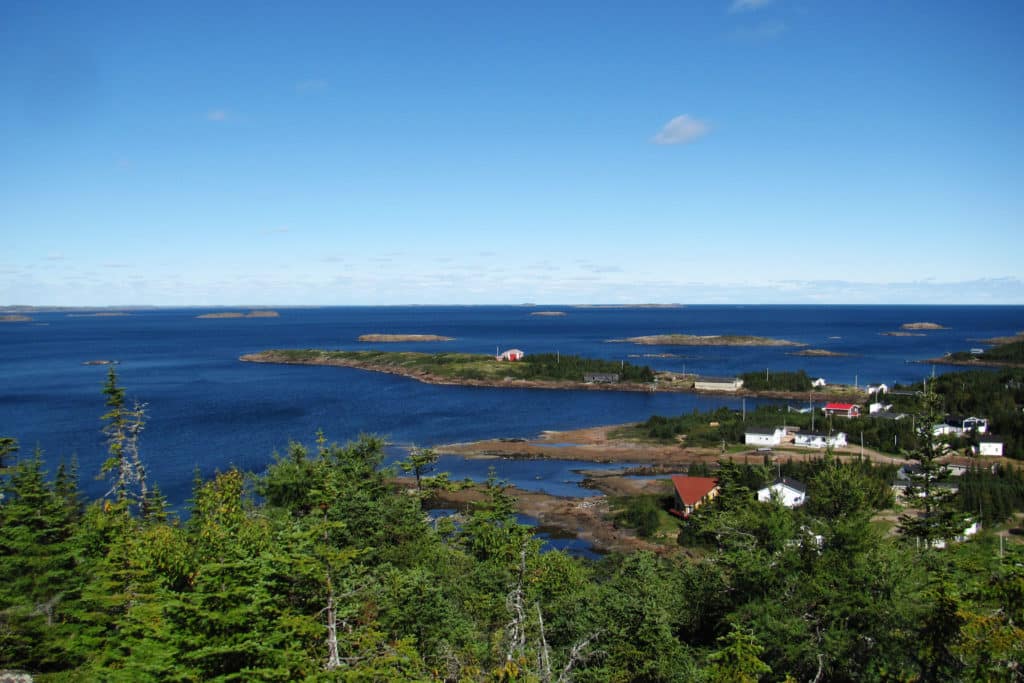
As our 31-foot Cape George cutter, Ganymede, sailed across the Strait of Belle Isle with a brisk one-reef breeze on her starboard quarter, I thought to myself that we were leaving the wildest, loneliest place we would ever visit. Though it has a few concentrations of population, Newfoundland is generally sparsely settled in comparison with Nova Scotia or Maine or pretty much anywhere else we’ve ever been. Even the acres upon acres of steaming, remote rainforest on the south coast of Panama host more towns and villages than Newfoundland’s Great Northern Peninsula, where the ghosts and bones of abandoned whaling and cod-fishing camps are easier to find than harbors with actual people.
Our last few stops in Newfoundland — Quirpon, Cape Onion and Savage Cove — seemed to have more empty houses than occupied ones, and we talked to fewer than 10 people between all three. Savage Cove was swallowed up in fog as Danielle, my wife, steered Ganymede across the Strait of Belle Isle toward Blanc-Sablon, a hamlet on the border of Quebec and Labrador. We had spent the summer cruising ever northward to the top of the Great Northern Peninsula, and had cut the season slightly finer than was perhaps prudent. It had been a bad season for gales, the local fishermen said time and again, and we were relieved to be making southing toward warmer climates before the real fall storms could set in.
We were in the northeast part of the Gulf of St. Lawrence, which, due to winds funneling through the Strait of Belle Isle and weather coming up from the south to meet it, is its own special forecast region in the VHF weather broadcasts. The stretch of Quebec’s coast before us, from Blanc-Sablon to Cape Whittle, is lined by an archipelago of islands packed densely together and riddled with narrow channels wending here and there among them, often providing miles of sheltered inland water to any sailor who feels adventurous enough to wiggle in.
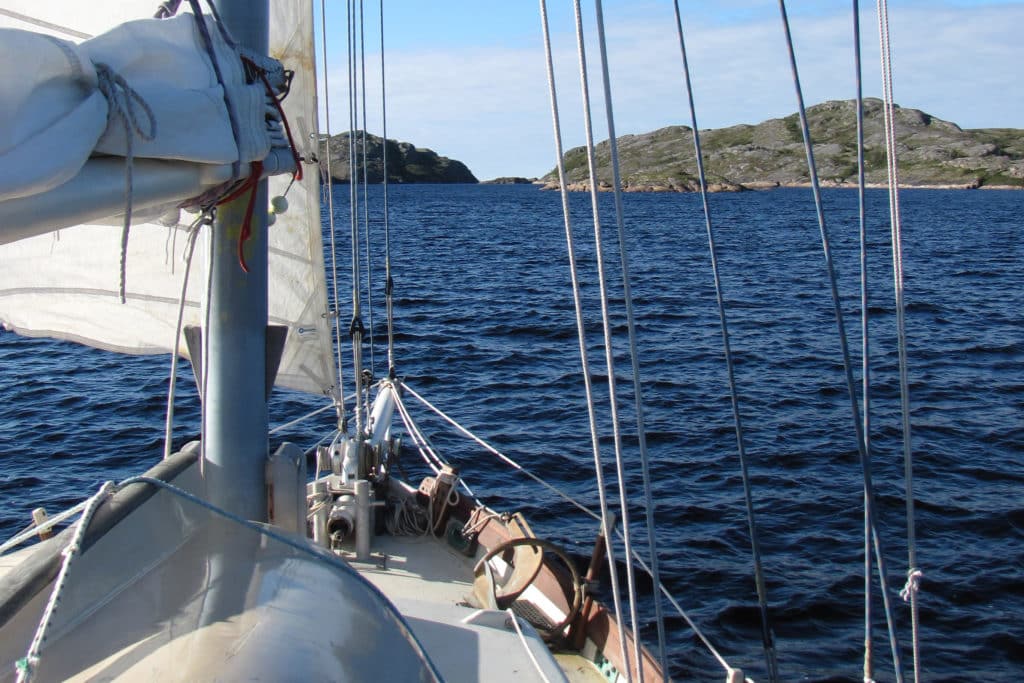
We were not feeling particularly adventurous as we approached the coast; we’d had plenty of adventure in the last five months. We simply wanted to get along as quickly as possible before things got too cold. Alas, this coast is fraught with adventure, and we endured more than one before all was said and done. It began in the first tiny cove we entered. Surrounded by low, round, rocky islets, we saw little to distinguish one opening in the rocks from the next, and we avoided the wrong one at the last moment, after changing our minds about it six times.
GPS is not much help in this remote stretch of Quebec because the ancient charts and actual geography don’t match up. The GPS fix is sometimes on, usually off and generally inconsistent. It made for some interesting foggy mornings as we tried to wend along narrow, unbuoyed passages between submerged rocks. Taking compass bearings didn’t help much because iron deposits under the seabed pull the magnets this way and that, making constant vigilance an absolute must. The best thing to do, we found as we wove through hammering rain into Baie des Esquimaux, was to use the GPS merely for a true heading, and extrapolate position bearings from that.
The scenery here could not have been more different from that of Newfoundland. While the latter had been all green woods, sharp gray cliffs and deep, fjordlike indentations, here the hills were more rounded, the granite almost always pink, and the vegetation limited to small, stunted bushes and tundralike, colorful mosses — often more than knee-deep. What stood out most along this coast was the unbelievable number of waterfalls. Everywhere we looked were roaring cascades and foaming watercourses. One narrow harbor had so many waterfalls that there was quite a strong current flowing out of it, just a few hundred yards in from the open sea.
There are far fewer settlements along this coast than in Newfoundland, and all of them are “outports,” meaning they’re accessible only by water, when the ice allows. A few of them are visited by bush planes landing on gravel strips, and some have a 5-mile or so loop of road, usually connecting the ferry landing to the actual settlement. Each of the three villages we visited in the 200 miles of rockbound coast between Blanc-Sablon and Natashquan was unique in its own way, though peopled by the same Irish descendants as Newfoundland. Rivière-Saint-Paul, nestled between hills at the mouth of a long river that empties into the sheltered waters of Baie des Esquimaux, was our first taste of civilization.
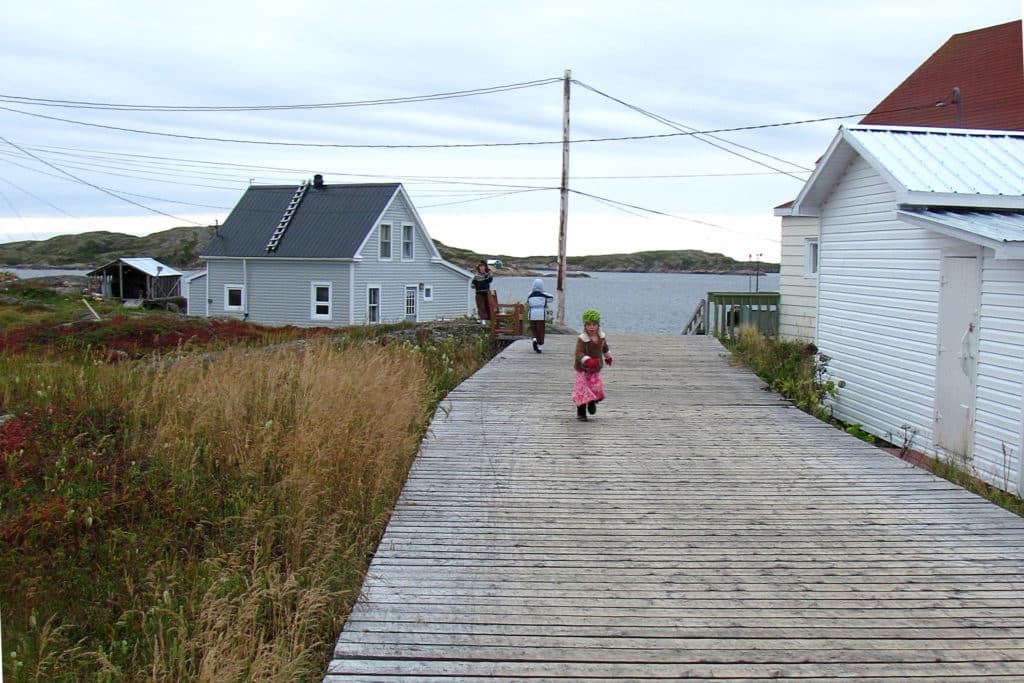
It was a wet day. The long arm of Tropical Storm Gabrielle, passing far to seaward in the North Atlantic, had contributed a deluge that left me and the cabin mostly soaked as I popped in and out between chart and cockpit, trying to pilot Ganymede safely past dozens of identical islands in the tortuous approach. It was a pleasant surprise, as I trudged along a sturdy boardwalk, to see houses not battered and tumbledown, but as tidy and well-kept as in any seaside town that depends on tourists for its keep. Everything looked fastidiously maintained and clean, like in a quaint Maine lobster village. I couldn’t fathom what anyone did here, since there wasn’t a fishing fleet, and it was obvious that tourists and even cruising sailors were a rarity.
We weren’t there long enough to find out. The one person I met, who gave me a lift to buy fuel ($8 a gallon!) and groceries, was a fur trapper who worked the river for mink, otter and muskrat, but that didn’t seem to be the universal employment. As with everywhere else pleasant we’d been, we would have liked to have more time to stay, but there was a fair breeze forecast for the next day, and such things are not to be wasted so late in the short northern season.
I use the term “fair breeze” to mean only that it was going the same direction we were. There was rather too much of it, especially when we left the shelter of the scattered islands west of Baie des Esquimaux. It was under storm trysail and reefed staysail that we whooshed into our next harbor to wait out the rest of the blow — a Parthian shot from the departing tropical storm. The next morning we had only a few hours of quiet to get to another hidey-hole and hunker down again for a gale from the opposite direction.
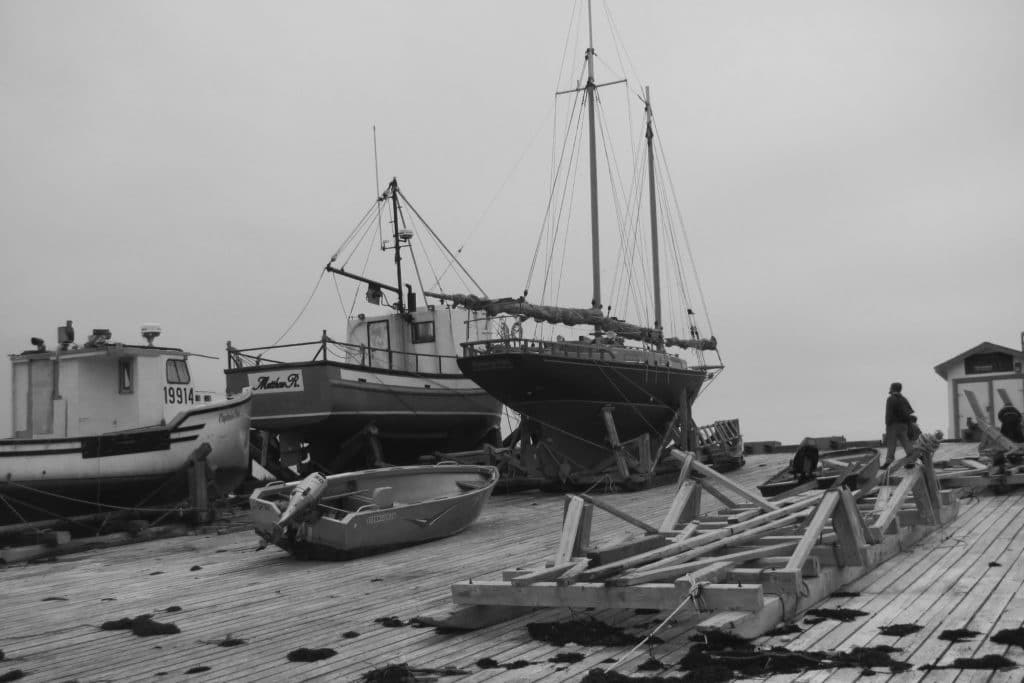
So it went on the coast of Quebec: We would snatch a few miles when we could during the interludes, then scurry into a sheltered nook through a passage so narrow we could touch the cliffs on each side with a boathook. It was only September — still hot summer back home in Rhode Island — but we made frequent use of the wood stove, not only for heat but to keep things dry in the perpetual damp. It was a relief when we finally made our splashy way into the pass between Cumberland and Portage islands, as we knew that for at least a couple of days, the wind and waves could do what they wanted without affecting us. Ganymede chugged through quiet, silky brown water among rocky, pinkish humps inhabited only by birds. Channels and passageways branched off in every direction, all calling out to be explored.
“I could spend a whole summer just cruising between here and Baie des Esquimaux,” I told Danielle, who was scoping for eagles’ nests with the binoculars.
“You say that about everywhere we’ve been,” she pointed out.
“Yeah, but I could extra do it here, if only we could carry enough food.”
“Maybe we’ll be able to come back someday. It’s not likely to change too much.”
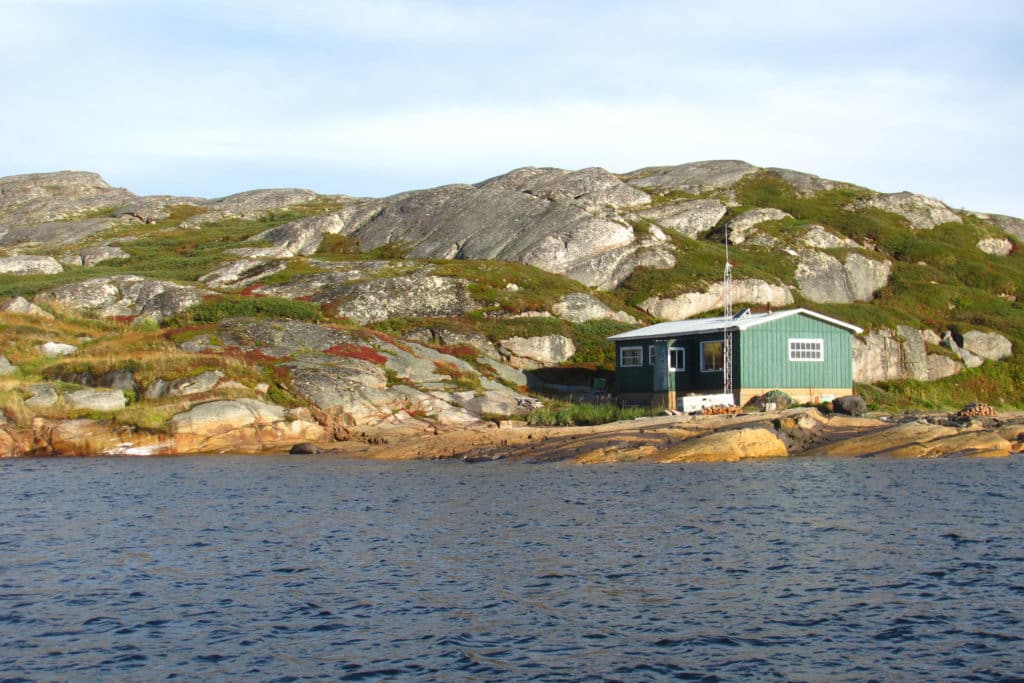
She was right about that. This coast had a permanent look about it. Solid. Slow. Patient. It probably looked exactly the same as it had when Jacques Cartier first poked around several hundred years ago. That night we anchored in serene quietness in a little unnamed cove next to a thin, long inland passage called the Petit Rigolet, or “Little Ree-gullet,” as the locals say it. On the pebbly beach ashore, as if to prove that we weren’t the only people left on Earth (though it felt that way, after days of seeing not a soul), we found a porcelain teacup buried upside down at the water’s edge. It remains to this day one of my favorite souvenirs of our travels.
The biggest settlement on this stretch of coast, La Tabatière, is home to an enormous hydroelectric plant that sends power not only to all the outports, through wires strung on towers high above the roadless tundra, but as far as Blanc-Sablon and Labrador. We reached it after another windy obstacle-course sail through steep, narrow gaps and bare, rounded islands. With most of the fishing boats being hauled out for the season, there was room to tie up in a nook behind the giant ferry dock. A two-minute walk up the hill revealed a view of a vast lake and a crumbling weir no longer used for generating electricity.
As the epicenter of the Northeast Gulf outports, La Tabatière boasts two grocery stores and one restaurant and bar that even had a Wi-Fi connection. (My trapper friend in Rivière-Saint-Paul had claimed he’d heard of the Internet, but wasn’t sure whether someone in town had one or not.) La Tabatière did not have a much-needed laundromat, but the woman at the grocery store was good enough to invite us to do laundry at her house. So on the evening of our arrival, we enjoyed some true Canadian hospitality in the house of a perfect stranger: hot baths, laundry and even cartoons on a flat-screen television for the kids while our new friend, Janice Robertson, told us tales of growing up along this wildest coast.
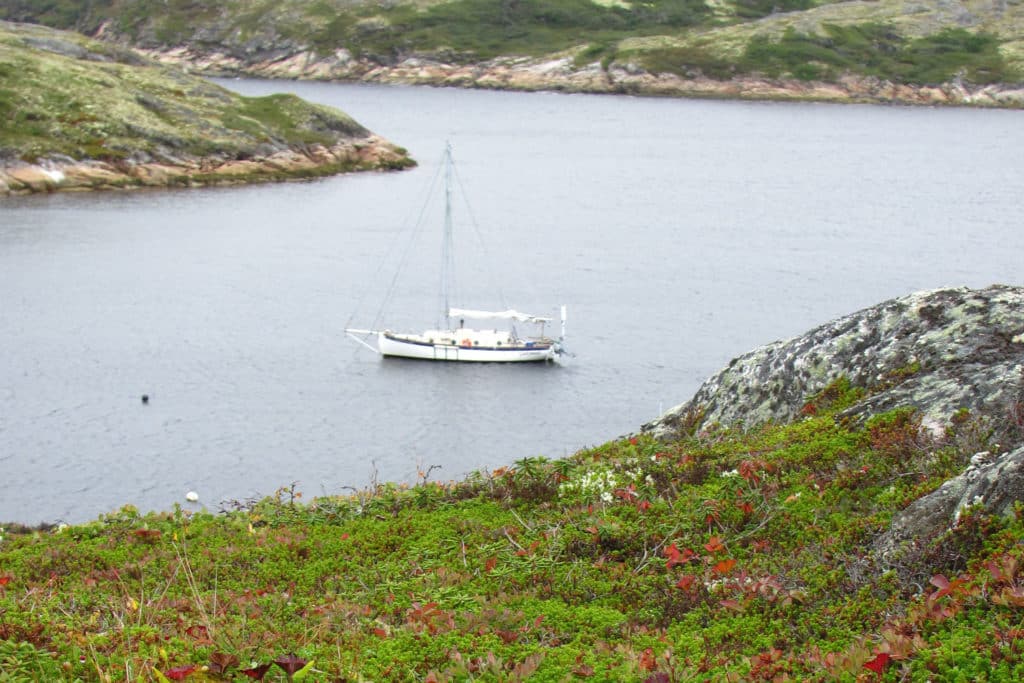
We would have loved to stay longer to hear more stories of her grandfather, who delivered mail by schooner in summer and dog sled in winter all along the northeastern coast of Quebec and southern Labrador; of driving pickup trucks on solid sea ice from Natashquan through Little Ree-gullet to visit family in Rivière-Saint-Paul; of these remarkable people who live with such aplomb in such a lonely, faraway place, and manage not only to survive but thrive. But our weather window came, and we made tracks for Harrington, a tiny island with no roads or cars — just wide boardwalks along which people drive four-wheelers. Every house had a sled or two parked in front, and for want of a Travelift, all the boats were hauled out on a huge wooden ramp fitted with winches at the top.
There was ice on the decks the next morning as we sailed away, double-reefed, for Cape Whittle, the obstacle we’d been dreading since putting Belle Isle behind us. Capes are notorious for causing difficulties — our worst times sailing have been trying to round capes: Burica, Cape May, Cape Sable, Cape John — and the weather station at Cape Whittle had been reporting winds 15 or so knots stronger than neighboring sites. It was a grand sail down, however, and as we came near, the wind dropped to a whisper, then fell flat calm. Losing no time, we started the motor and left the cape behind as quickly as possible. Taking advantage of the quiet, we made our longest daytime run ever — 70 miles — all the way to Washicoutai Bay, an uninhabited, narrow curving arm that sheltered Ganymede through the raging storm that the eerie calm had presaged.
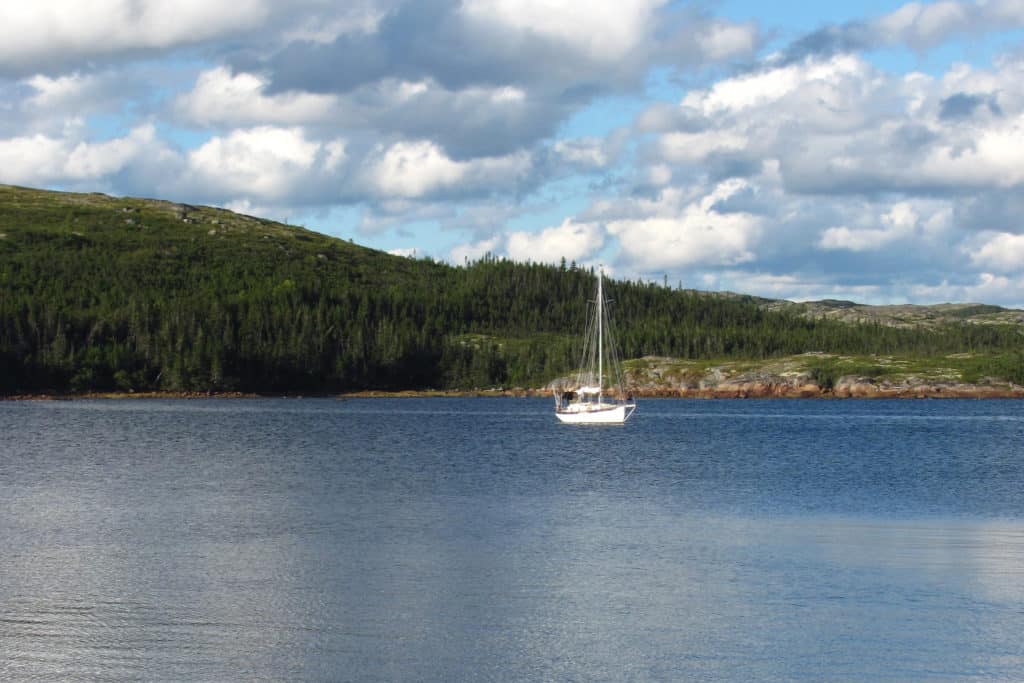
We celebrated our safe rounding of Cape Whittle by resting for a few days while the weather collapsed in sheets of rain and shrieking wind. We also celebrated Emily’s 7th birthday, with a fire in the stove, a cake in the oven, marshmallows from the tiny store on Harrington Island, and an assortment of small presents and balloons that had been gathered here and there as we touched civilized parts of Newfoundland.
It was one of the best birthdays ever, but being on the equinox, it was also a reminder that our once-long northern days were fast becoming long northern nights. There were still many hundreds of miles to sail before November, and though we’d got around Cape Whittle and would soon drop below 52 degrees of north latitude, the mighty St. Lawrence River yawned ahead, full of shoals, ships and ripping tides. Still, you can only sail one day at a time, and the very next chance there was, we made for Natashquan. The highway from Québec City ends there, and civilization begins: well-stocked stores, cars, banks and reasonable gas prices — a palpable difference from the Wildest Coast that we had just cruised.
We think of the northeastern coast of Quebec often, now that we’re far away at home. We talk to the one or two cruisers we know who’ve been there, and we keep in touch with Janice Robertson. There’s no place quite as lonely, beautiful, wild and dangerous, with adventure and discovery around every turn — a most fitting reward for any cruiser who would venture off the beaten path.
Ben Zartman will be giving a talk at the LL Bean store in Freeport, Maine, all about Ganymede‘s construction and voyage, from San Francisco to Newport, then around Newfoundland and the Canadian Maritimes. Come see him if you are in the area Friday March 25, 7:00 PM. Admission is free!
The Zartman family is currently land-bound in Bristol, Rhode Island, planning their next adventure.








